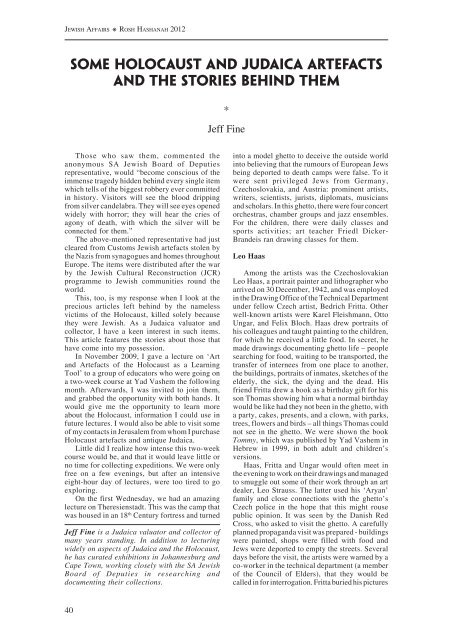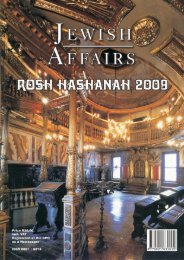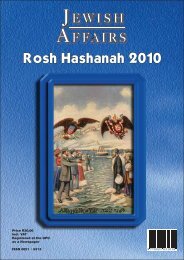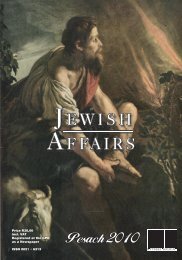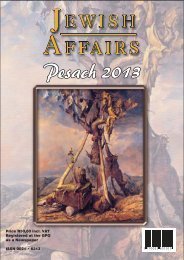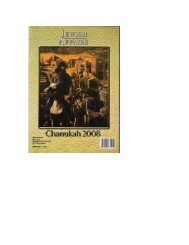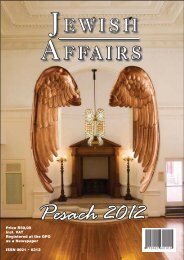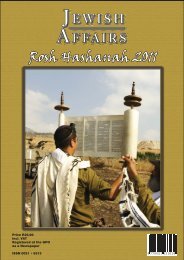Jewish Affairs - South African Jewish Board of Deputies
Jewish Affairs - South African Jewish Board of Deputies
Jewish Affairs - South African Jewish Board of Deputies
- No tags were found...
You also want an ePaper? Increase the reach of your titles
YUMPU automatically turns print PDFs into web optimized ePapers that Google loves.
JEWISH AFFAIRS ROSH HASHANAH 2012SOME HOLOCAUST AND JUDAICA ARTEFACTSAND THE STORIES BEHIND THEM*Jeff FineThose who saw them, commented theanonymous SA <strong>Jewish</strong> <strong>Board</strong> <strong>of</strong> <strong>Deputies</strong>representative, would “become conscious <strong>of</strong> theimmense tragedy hidden behind every single itemwhich tells <strong>of</strong> the biggest robbery ever committedin history. Visitors will see the blood drippingfrom silver candelabra. They will see eyes openedwidely with horror; they will hear the cries <strong>of</strong>agony <strong>of</strong> death, with which the silver will beconnected for them.”The above-mentioned representative had justcleared from Customs <strong>Jewish</strong> artefacts stolen bythe Nazis from synagogues and homes throughoutEurope. The items were distributed after the warby the <strong>Jewish</strong> Cultural Reconstruction (JCR)programme to <strong>Jewish</strong> communities round theworld.This, too, is my response when I look at theprecious articles left behind by the namelessvictims <strong>of</strong> the Holocaust, killed solely becausethey were <strong>Jewish</strong>. As a Judaica valuator andcollector, I have a keen interest in such items.This article features the stories about those thathave come into my possession.In November 2009, I gave a lecture on ‘Artand Artefacts <strong>of</strong> the Holocaust as a LearningTool’ to a group <strong>of</strong> educators who were going ona two-week course at Yad Vashem the followingmonth. Afterwards, I was invited to join them,and grabbed the opportunity with both hands. Itwould give me the opportunity to learn moreabout the Holocaust, information I could use infuture lectures. I would also be able to visit some<strong>of</strong> my contacts in Jerusalem from whom I purchaseHolocaust artefacts and antique Judaica.Little did I realize how intense this two-weekcourse would be, and that it would leave little orno time for collecting expeditions. We were onlyfree on a few evenings, but after an intensiveeight-hour day <strong>of</strong> lectures, were too tired to goexploring.On the first Wednesday, we had an amazinglecture on Theresienstadt. This was the camp thatwas housed in an 18 th Century fortress and turnedJeff Fine is a Judaica valuator and collector <strong>of</strong>many years standing. In addition to lecturingwidely on aspects <strong>of</strong> Judaica and the Holocaust,he has curated exhibitions in Johannesburg andCape Town, working closely with the SA <strong>Jewish</strong><strong>Board</strong> <strong>of</strong> <strong>Deputies</strong> in researching anddocumenting their collections.into a model ghetto to deceive the outside worldinto believing that the rumours <strong>of</strong> European Jewsbeing deported to death camps were false. To itwere sent privileged Jews from Germany,Czechoslovakia, and Austria: prominent artists,writers, scientists, jurists, diplomats, musiciansand scholars. In this ghetto, there were four concertorchestras, chamber groups and jazz ensembles.For the children, there were daily classes andsports activities; art teacher Friedl Dicker-Brandeis ran drawing classes for them.Leo HaasAmong the artists was the CzechoslovakianLeo Haas, a portrait painter and lithographer whoarrived on 30 December, 1942, and was employedin the Drawing Office <strong>of</strong> the Technical Departmentunder fellow Czech artist, Bedrich Fritta. Otherwell-known artists were Karel Fleishmann, OttoUngar, and Felix Bloch. Haas drew portraits <strong>of</strong>his colleagues and taught painting to the children,for which he received a little food. In secret, hemade drawings documenting ghetto life – peoplesearching for food, waiting to be transported, thetransfer <strong>of</strong> internees from one place to another,the buildings, portraits <strong>of</strong> inmates, sketches <strong>of</strong> theelderly, the sick, the dying and the dead. Hisfriend Fritta drew a book as a birthday gift for hisson Thomas showing him what a normal birthdaywould be like had they not been in the ghetto, witha party, cakes, presents, and a clown, with parks,trees, flowers and birds – all things Thomas couldnot see in the ghetto. We were shown the bookTommy, which was published by Yad Vashem inHebrew in 1999, in both adult and children’sversions.Haas, Fritta and Ungar would <strong>of</strong>ten meet inthe evening to work on their drawings and managedto smuggle out some <strong>of</strong> their work through an artdealer, Leo Strauss. The latter used his ‘Aryan’family and close connections with the ghetto’sCzech police in the hope that this might rousepublic opinion. It was seen by the Danish RedCross, who asked to visit the ghetto. A carefullyplanned propaganda visit was prepared - buildingswere painted, shops were filled with food andJews were deported to empty the streets. Severaldays before the visit, the artists were warned by aco-worker in the technical department (a member<strong>of</strong> the Council <strong>of</strong> Elders), that they would becalled in for interrogation. Fritta buried his pictures40


